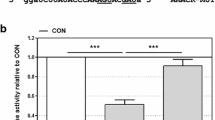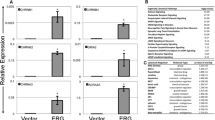Abstract
α-Methylacyl-CoA racemase (AMACR) is an enzyme involved in β-oxidation of branched-chain fatty acids and bile acid intermediates. Recent works have revealed that AMACR is overexpressed in prostate cancer and functionally important for the growth of prostate cancer cells. Despite the recent interest in AMACR as a diagnostic marker for prostate cancer, little is known about the transcriptional regulation of AMACR in prostate cancer. To elucidate the regulation of the AMACR gene, a 2.3-kb fragment of its 5′ flanking region was cloned into pGL3-Basic, then using tansfection and Dual-luciferase reporter assay, a preliminary analysis on promoter activity and function of this 2.3-kb sequence was carried out. This 2.3-kb fragment represented promoter activity that consistent with the expression level in LNCaP and PC-3 cells respectively. Transfection experiments of 5′-deletion mutants into LNCaP cells revealed a positive-regulatory region located between nucleotides −423 and −93 that may be responsible for AMACR transactivation in LNCaP cells. Cotransfection experiments revealed that promoter activity of this 2.3-kb sequence was down-regulated by C/EBPα, p53, NF-κB p50. And data from luciferase-based reporter assays suggest that the promoter function of AMACR is independent of androgen receptor-mediated signaling.






Similar content being viewed by others
References
Ferdinandusse S, Denis S, Clayton PT, Graham A, Rees JE, Allen JT, McLean BN, Brown AY, Vreken P, Waterham HR, Wanders RJ (2000) Mutations in the gene encoding peroxisomal α-methylacyl-CoA racemase cause adult-onset sensory motor neuropathy. Nat Genet 24:188–191
Jiang Z, Woda BA, Yang XJ (2002) α-methylacyl coenzyme A racemase as a marker for prostate cancer. JAMA 287:3080–3081
Luo J, Zha S, Gage WR, Dunn TA, Hicks JL, Bennett CJ, Ewing CM, Platz EA, Ferdinandusse S, Wanders RJ, Trent JM, Isaacs WB, De Marzo AM (2002) α-methylacyl-CoA racemase: a new molecular marker for prostate cancer. Cancer Res 62:2220–2226
Rubin MA, Zhou M, Dhanasekaran SM, Varambally S, Barrette TR, Sanda MG, Pienta KJ, Ghosh D, Chinnaiyan AM (2002) α-methylacyl coenzyme A racemase as a tissue biomarker for prostate cancer. JAMA 287:1662–1670
Jiang Z, Woda BA, Rock KL, Xu Y, Savas L, Khan A, Pihan G, Cai F, Babcook JS, Rathanaswami P, Reed SG, Xu J, Fanger GR (2001) P504S: a new molecular marker for the detection of prostate carcimona. Am J Surg Pathol 25:1397–1404
Zha S, Ferdinandusse S, Denis S, Wanders RJ, Ewing CM, Luo J, De Marzo AM, Isaacs WB (2003) α-methylacyl-CoA racemase as an androgen independent growth modifier in prostate cancer. Cancer Res 63:7365–7376
Kuefer R, Varambally S, Zhou M, Lucas PC, Loeffler M, Wolter H, Mattfeldt T, Hautmann RE, Gschwend JE, Barrette TR, Dunn RL, Chinnaiyan AM, Rubin MA (2002) α-Methylacyl-CoA Racemase: expression levels of this novel cancer biomarker depend on tumor differentiation. Am J Pathol 161:841–848
Zha S, Isaacs WB (2005) A nonclassic CCAAT enhancer element binding protein binding site contributes to α-Methylacyl-CoA Racemase expression in prostate cancer. Mol Cancer Res 3:110–118
Meyers FJ, Gumerlock PH, Chi SG, Borchers H, Deitch AD, deVere White RW (1998) Very frequent p53 mutations in metastatic prostate carcinoma and in matched primary tumors. Cancer 83:2534–2539
Burchardt M, Burchardt T, Shabsigh A, Ghafar M, Chen MW, Anastasiadis A, de la Taille A, Kiss A, Buttyan R (2001) Reduction of wild type p53 function confers a hormone resistant phenotype on LNCaP prostate cancer cells. Prostate 48:225–230
Miyashita T, Reed JC (1995) Tumor suppressor p53 is a direct transcriptional activator of the human bax gene. Cell 80:293–299
Okamoto K, Beach D (1994) Cyclin G is a transcriptional target of the p53 tumor suppressor protein. EMBO J 13:4816–4822
Kley N, Chung RY, Fay S, Loeffler JP, Seizinger BR (1992) Repression of the basal c-fos promoter by wild-type p53. Nucleic Acids Res 20:4083–4087
Miyashita T, Harigai M, Hanada M, Reed JC (1994) Identification of a p53-dependent negative response element in the bcl-2 gene. Cancer Res 54:3131–3135
Werner H, Karnieli E, Rauscher FJ, LeRoith D (1996) Wild-type and mutant p53 differentially regulate transcription of the insulin-like growth factor I receptor gene. Proc Natl Acad Sci USA 93:8318–8323
Liu X, Miller CW, Koeffler PH, Berk AJ (1993) The p53 activation domain binds the TATA box-binding polypeptide in Holo-TFIID, and a neighboring p53 domain inhibits transcription. Mol Cell Biol 13:3291–3300
Seto E, Usheva A, Zambetti GP, Momand J, Horikoshi N, Weinmann R, Levine AJ, Shenk T (1992) Wild-type p53 binds to the TATA-binding protein and represses transcription. Proc Natl Acad Sci USA 89:12028–12032
Borellini F, Glazer RI (1993) Induction of Sp1-p53 DNA-binding heterocomplexes during granulocyte/macrophage colony-stimulating factor-dependent proliferation in human erythroleukemia cell line TF-1. J Biol Chem 268:7923–7928
Agoff SN, Hou J, Linzer DI, Wu B (1993) Regulation of the human hsp70 promoter by p53. Science 259:84–87
Desdouets C, Ory C, Matesic G, Soussi T, Brechot C, Sobczak-Thepot J (1996) ATF/CREB site mediated transcriptional activation and p53 dependent repression of the cyclin A promoter. FEBS Lett 385:34–38
Lekstrom-Himes J, Xanthopoulos KG (1998) Biological role of the CCAAT/enhancer-binding protein family of transcription factors. J Biol Chem 273:28545–28548
Pabst T, Mueller BU, Zhang P, Radomska HS, Narravula S, Schnittger S, Behre G, Hiddemann W, Tenen DG (2001) Dominant negative mutations of CEBPA, encoding CCAAT/enhancer bindingprotein-α (C/EBPα), in acute myeloid leukemia. Nat Genet 27:263–270
Halmos B, Huettner CS, Kocher O, Ferenczi K, Karp DD, Tenen DG (2002) Down-regulation and antiproliferative role of C/EBPα in lung cancer. Cancer Res 62:528–534
Gery S, Tanosaki S, Bose S, Bose N, Vadgama J, Koeffler HP (2005) Down-regulation and growth inhibitory role of C/EBP α in breast cancer. Clin Cancer Res 11:3184–3190
Timchenko NA, Wilde M, Nakanishi M, Smith JR, Darlington GJ (1996) CCAAT/enhancer-binding protein α (C/EBPα) inhibits cell proliferation through the p21 (WAF-1/CIP-1/SDI-1) protein. Genes Dev 10:804–805
Porse BT, Pedersen TA, Xu X, Lindberg B, Wewer UM, Friis-Hansen L, Nerlov C (2001) E2F repression by C/EBPα is required for adipogenesis and granulopoiesis in vivo. Cell 107:247–248
Yin H, Radomska HS, Tenen DG, Glass J (2006) Down regulation of PSA by C/EBP α is associated with loss of AR expression and inhibition of PSA promoter activity in the LNCaP cell line. BMC Cancer 6:158
Chattopadhyay S, Gong EY, Hwang M, Park E, Lee HJ, Hong CY, Choi HS, Cheong JH, Kwon HB, Lee K (2006) The CCAAT enhancer-binding protein-α negatively regulates the transactivation of androgen receptor in prostate cancer cells. Mol Endocrinol 20:984–995
Foo SY, Nolan GP (1999) NF-κB to the rescue: RELs, apoptosis and cellular transformation. Trends Genet 15:229–235
Seitz CS, Lin Q, Deng H, Khavari PA (1998) Alterations in NF-κB function in transgenic epithelial tissue demonstrate a growth inhibitory role for NF-κB. Proc Natl Acad Sci USA 95:2307–2312
Ko S, Shi L, Kim S, Song CS, Chatterjee B (2007) Interplay of NF-κB and B-myb in the negative regulation of androgen receptor expression by TNFα. Mol Endocrinol. doi:10.1210/me.2007-0332
Cinar B, Yeung F, Konaka H, Mayo MW, Freeman MR, Zhau HE, Chung LW (2004) Identification of a negative regulatory cis-element in the enhancer core region of the prostate-specific antigen promoter: implications for intersection of androgen receptor and nuclear factor-κB signalling in prostate cancer cells. Biochem J 379:421–431
Williams SA, Chen LF, Kwon H, Ruiz-Jarabo CM, Verdin E, Greene WC (2006) NF-κB p50 promotes HIV latency through HDAC recruitment and repression of transcriptional initiation. EMBO J 25:139–149
Dehm SM, Tindall DJ (2006) Molecular regulation of androgen action in prostate cancer. J Cell Biochem 99:333–344
Coutinho-Camillo CM, Salaorni S, Sarkis AS, Nagai MA (2006) Differentially expressed genes in the prostate cancer cell line LNCaP after exposure to androgen and anti-androgen. Cancer Genet Cytogenet 166:130–138
Mobley JA, Leav I, Zielie P, Wotkowitz C, Evans J, Lam YW, L’Esperance BS, Jiang Z, Ho SM (2003) Branched fatty acids in dairy and beef products markedly enhance α-methylacyl-CoA racemase expression in prostate cancer cells in vitro. Cancer Epidemiol Biomarkers Prev 12:775–783
Acknowledgments
The authors are grateful to Dr. Young for kindly providing the pcDNA3.1-Sp1, pcDNA3.1-PTEN and pSG5-hAR, Dr. Shao for kindly providing the pcDNA3.1-PPARγ 2 and pcDNA3.1-C/EBPα, Dr. He for kindly providing the pBABEpuro-ras and pBABEhygro-myc used in this study. This work was supported by the National Natural Science Foundation supporting project (No. 30371564).
Author information
Authors and Affiliations
Corresponding authors
Additional information
W. Chen and W. Wu contributed equally to the work.
Rights and permissions
About this article
Cite this article
Chen, W., Wu, W., Zhao, J. et al. Molecular cloning and preliminary analysis of the human α-methylacyl-CoA racemase promoter. Mol Biol Rep 36, 423–430 (2009). https://doi.org/10.1007/s11033-007-9196-x
Received:
Accepted:
Published:
Issue Date:
DOI: https://doi.org/10.1007/s11033-007-9196-x




